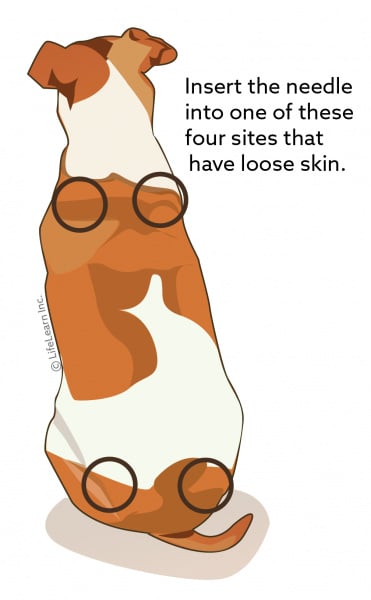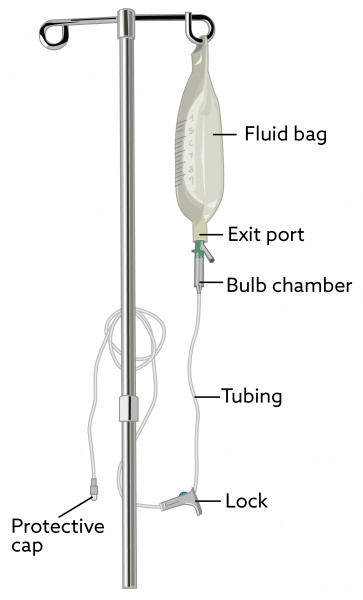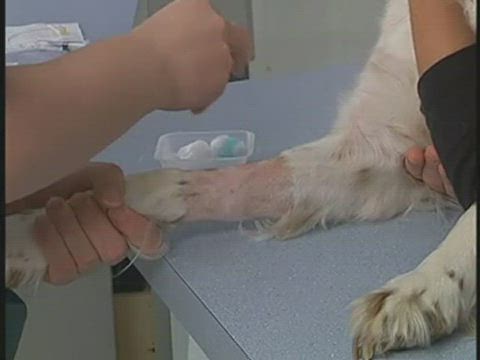starting an iv on a dog
Wipe the area down with. While holding onto the hub of the catheter insert the IV catheter directly into the vein at an approximately 10-30 degree angle.

Diy Pet Stairs Simple Steps You Can Make Yourself Pet Stairs Dog Stairs Pet Gear
They are commonly used for any cause of dehydration and for conditions such as kidney disease and any cause of vomiting and diarrhea.

. A calm environment will help keep the dog calm and cooperative. Start closer to the head initially so if the first try is unsuccessful you can move farther down the neck. IV should now be stabilized with tape to ensure that it stays in.
This is usually at a slow controlled rate and may be just what the vet wants. Attach the fluid line by inserting the point of. In the hind limb they are most commonly placed in the lateral saphenous vein.
Up to 25 cash back Typically we place IV catheters in the cephalic vein on one of the front arms. Connect the IV set to the needle. Fluids are critical to dogs.
The IV set will have to be pressed in the hole of the IV bag. Add Tip Ask Question Comment Download. Make sure there are no leaks so that all the fluid will enter the dogs system.
Manchester the kentucky transportation cabinet kytc advises motorists that dog branch school road cr 1341 in laurel county between the intersection with white oak road and intersection with dog branch road will be closed to through traffic starting at 8 am. Often a vein will feel great on these patients but in reality the walls are so thick and the lumen is so small that it. Intravenous IV fluids are a common way to administer fluids to dogs at the veterinary hospital.
First gather supplies and perform hand hygiene. Flush extension set with saline flush. Prepare the IV tubing.
Hang the IV medication bag above where the dog will be placed. If necessary clamp the tubing so that the solution doesnt drip onto the floor. Grasp the skin with one hand and gently tent it upwards drawing the skin up from the underlying muscle.
Next prime the IV tubing by suspending the IV bag from an elevated stand filling the tubing with saline solution and checking for any bubbles. The bevel of the catheter should ideally be facing upwards. We will tell you what intravenous fluids are and how they are administered.
Rotate IV catheter and reseat if recommended by manufacturer Prep any labeling. This is done by placing your hand under the elbow so that the dog cannot move its leg back and taking your thumb over the top of the leg and applying pressure so that the cephalic vein will fill with blood and become more visible. Rinse the clipped area with rubbing alcohol.
To start a typical iv line you will need. Peripheral indwelling IV catheters are most commonly placed in the cephalic vein in dogs and cats. An essential step in consistently establishing IVs especially when your patient has those dreaded rolling veins is stabilizing the target vein.
Press the sharp end of the needle firmly into the skin between where your hand holds the skin and the solid muscle of the pups body. Set up your work. Maybe you can thread the rubber tubing through the hot dog.
Other than another person Ive only seen those phlebIV arms that will give blood or a flash. For suturing we used pigs feet or hamhocks from the butcher. Insert 5 ml syringe of normal saline into the saline port to ensure that fluids are able to move freely through the IV.
Advance the needle slightly forward while pulling the roll of skin towards the needle. The non-dominant hand should be used to restrain the distal limb simultaneously. Inject 1 milliliter of lidocaine under the skin directly over the jugular vein where you want to place the catheter.
With your nondominant hand gently pull up your dogs scruff skin just behind the neck with your thumb and index finger. Introduce a needle in the dogs back in the shoulder blade area or another area with loose skin. Often an IV catheter will slip from the vein and lodge under the skin allowing the fluid to collect there.
Placement of an IV catheter IV fluids in a dog - Surgery to be done is a Ovariohysterectomy. Find a clean quiet work space. Think about your patient their reason for hospitalisation and their.
The best location to place the needle is between the shoulder blades. This procedure is per. Other veins used often for catheterisation include the accessory cephalic and medial saphenous.
Have the triangles of the tent in line with your dogs spine rather than going from side to side. Some dogs will willingly give you their leg and allow you to take a blood sample without much restraint. Dogs and cats can absorb fluids lodged under their skins without incident.
If you havent already maybe start feeling your friends familys veins with without gloves. IV drug abusers are not only a challenge because of lack of access but also because their veins tend to blow much easier due to repeated abuse. In this VETgirl online veterinary continuing education video we demonstrate how to place an intravenous IV catheter in a dog or cat.
Prime saline flush and remove air bubble. Lay the point of the needle at the base of the roll of skin with the needle level with the dogs body and pointing toward the dogs head assuming that the dog is in an upright or standing position. We clip the hair over the anterior surface of the leg halfway between the elbow and wrist carpal area or so.
How to Start an IV on a Dog Step 1. Steps on How to Insert an IV. Start at the center of the vein and move outward.
Or it may have been placed under the skin intentionally. Making a skin tent will make it easier for you to place the needle just under the skin. Next prepare the supplies.

Subcutaneous Fluid Administration In Dogs Vca Animal Hospitals

Subcutaneous Fluid Administration In Dogs Vca Animal Hospitals

Anthropomorphic Oil Painting Of One Of Joan Rivers Favorite Dogs As King George Iv Animal Portraits Art Dog Expressions Dog Art

Insert Witty Dog Name Here Animals Funny Animals Funny Dog Names Cute Animals

265 Intravenous Cannula Stock Photos Pictures Royalty Free Images Istock

Art Print Strike A Paws Iv By Anne Tavoletti 24x18in Dog Quotes Dog Signs Paw

7 Signs You Are Too Obsessed With Your Dog Your Dog Dogs Dog Clothes

How To Do A Canine Cephalic Vein Blood Collection Youtube

Intravenous Fluid Iv Fluids Therapy In Dogs

Veterinary Iv Catheter Taping Vet Tech School Vet Medicine Vet Tech Student

Tech Skills Canine And Feline Iv Catheter Alexander Street A Proquest Company

P I N T E R E S T M E G X X X 0 1 Chihuahua Chihuahua Dogs Cute Chihuahua

Pancreatitis In Dogs Symptoms Causes And More Pancreatitis In Dogs Dog Infographic Puppy Paws

Luxury Cozy Cave Show Dog Collection Snoozer Cozy Cave Dog Bed Dog Cave Dogs

How To Give Subcutaneous Fluids To Your Dog At Home Youtube

Low Serum Sodium Levels Can Occur Due To A Variety Of Conditions Start By Ruling Out These Differentials For Hyponatremia Dog Allergies Love Pet Dogs

You May Think That Her Arm Is Shaved From Her Iv But Thats Actually My New Watermark These Are The Terms Of Use You Must Promise To B White Dogs

Subcutaneous Fluid Administration In Dogs Diabetic Dog Pet Care Dogs Dogs

How To Place An Intravenous Iv Catheter Vetgirl Veterinary Ce Videos Youtube Vet School Veterinary Veterinarian Career